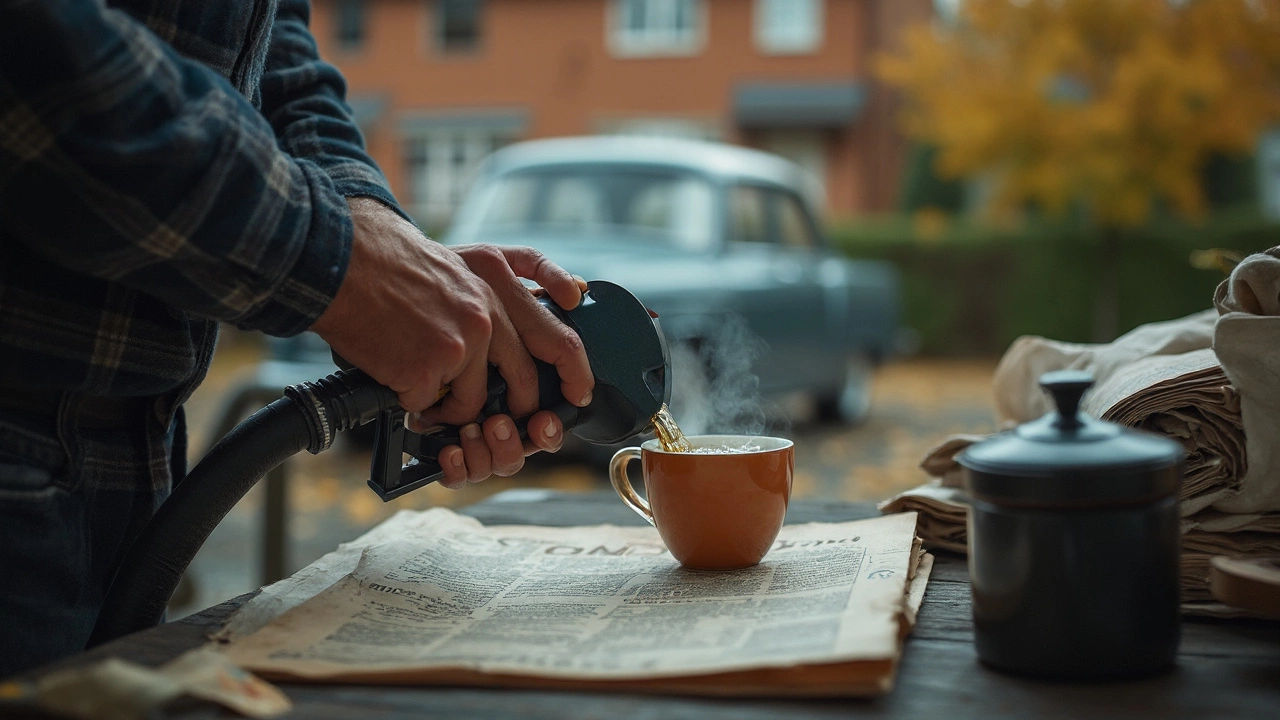Fuel pump problems can turn a good day into a total headache. Before you go hunting for a replacement, you might be surprised just how much life is left in that stubborn old pump. A lot of issues aren’t actually full-on pump failure—they’re clogs, electrical hiccups, or even something as basic as a wonky connection.
So, what do you do when you turn the key and your ride sputters or won’t fire up? You don’t need to throw money at a brand-new pump just yet. First, get a look at what’s actually causing the mess. Plenty of “dead” fuel pumps have been brought back to life with a good cleaning or a fresh relay. Sometimes, all that’s standing between you and a working car is a blown fuse or a grimy filter.
It’s way more common than you’d think for fuel pumps to act up because of dirt, corrosion, or electrical gremlins. Know what’s wild? Even something as simple as a loose ground wire has stranded more drivers than actual broken pumps. We’ll walk through some easy, money-saving fixes you can tackle yourself—with basic tools and a bit of patience.
- Spotting the Real Problem
- Cleaning and Quick-Fix Tricks
- Electrical Fixes on the Cheap
- When to Call It Quits
Spotting the Real Problem
Before you start fiddling with wires or yanking out parts, you gotta know what's actually messing with your fuel pump repair plan. Throwing parts at a problem without pinpointing it just wastes time and money. The fuel system is basically the heart of your engine—if it's starved, everything downstream goes wrong. Not every no-start or sputter is the pump’s fault.
About 70% of reported “fuel pump” issues come down to something else, like a blocked fuel filter, bad relay, or corroded ground. A weak pump can act up exactly like one that’s totally dead. So, start with a fast check for these classic symptoms:
- Long cranking when starting your car
- Sudden loss of power, especially climbing hills
- Engine stalls under load
- Strange whining noise near the fuel tank
If you hear the fuel pump running when you turn the key (a faint hum from the tank area), odds are the electrical side is still alive. No buzz? Time to dig into relays, fuses, and wiring before blaming the pump itself.
Try a simple fuel pressure test if you have a gauge. Low pressure usually points to a clogged filter, weak pump, or leaky line. High pressure? That could be a bad regulator, which also causes rough running. Here’s a quick look at what common issues mean:
| Symptom | Probable Cause |
|---|---|
| No start, no pump buzz | Blown fuse, bad relay, broken wire |
| Long cranking, weak power | Clogged filter, old pump |
| Intermittent stall | Loose connection, failing relay |
| Loud whining noise | Starved pump, clogged strainer |
Flip the key and listen carefully near the fuel tank—no hum means you should start at the fuse box or relay. And if your car’s old, don’t forget about corroded connectors, especially after a wet season or if you drive salty roads. Wiggling the wiring with the ignition on (careful not to short anything!) sometimes kicks a weak connection back to life, at least for troubleshooting. Start smart, and you’re already halfway to fixing the problem.
Cleaning and Quick-Fix Tricks
Getting a stuck fuel pump moving again doesn’t always need a full teardown. A big chunk of “broken” pumps just have dirt or buildup blocking the flow. First thing—check the fuel filter. If it’s clogged, it’ll choke off the pump, no matter how hard it tries. Swapping a filter is usually cheap and quick. Put in a fresh one, and you might feel like a hero.
Another sneaky culprit: gunky or corroded contacts on the pump's wiring. Even a thin layer of grime can block power. Unplug the harness, hit the metal bits with some contact cleaner, and plug it back in tight. If you see rust or green goop, clean both sides until it’s shiny again. It’s old-school, but it works.
Sticking to basics, listen to the pump for a second or two when you turn the ignition to ON (not start). If you hear a faint whir, that means it’s alive but might be choking on debris. Sometimes, a little fuel system cleaner in the tank can break up mild deposits inside the pump or lines. Stick with brands like Sea Foam or Chevron Techron—they’re known to work well for this.
Here’s something you might not hear at the shop: gentle taps on the fuel tank (right where the pump sits inside) with a rubber mallet can sometimes free up a jammed pump. It’s not a pro move, but if you’re stranded, it’s worth a shot. As Paul Brand, a veteran auto columnist, once put it:
“A few light raps on the tank are just enough to free up a stuck fuel pump impeller—sometimes that’s all you need to get home.”
If your car keeps dying or stumbling, and you suspect low pressure, try swapping out the old relay or fuse with a new one (they’re dirt cheap). Problems often start here before the core pump even gives out.
- Start with the fuel pump repair basics: clean terminals, fresh fuel filter.
- Use fuel system cleaner in the tank for suspected gunk.
- Check all wiring and replace sketchy relays or fuses.
- If stuck in a jam, a few careful knocks on the tank sometimes get you rolling again.
These tricks won’t bring back a totally shot pump, but they work more often than most folks expect. They’re quick, they’re cheap, and sometimes they’re all you need to get out of the driveway and back on the road.

Electrical Fixes on the Cheap
Before you swear your fuel pump is toast, check the simple electrical stuff. Most of these problems can be fixed without fancy tools or a trip to the mechanic. The truth? Electrical issues are behind loads of so-called fuel pump failures.
First up, look at the fuses. Your car’s manual will show you which fuse protects the fuel pump circuit. A blown fuse is an easy thing to fix—just swap it for a new one of the same rating. Don’t use a higher-rated fuse, or you’ll risk frying wires down the line.
- Fuel pump repair often starts with the relay. The relay is basically a remote switch telling the pump to turn on. If the relay’s bad, the pump won’t get power. Relays can be swapped from an identical part in your fuse box for a quick test. If the pump fires up, you know the relay was the problem.
- Corroded or loose connections cause all sorts of headaches. Pop the hood and check the wiring harness that leads to your fuel pump. Look for greenish corrosion, frayed wires, or sketchy crimp connections. Cleaning those contacts with electrical cleaner—and making sure everything is tight—can do wonders.
- Don’t rule out the ground wire. A wimpy or broken ground means the pump won’t get the juice it needs. Follow the ground from the pump and make sure it’s securely bolted to clean, bare metal on the frame. If in doubt, give it a quick brush with sandpaper and tighten it down again.
- If your ride’s really old, look for melted connectors or brittle insulation. These stop the pump from firing and can sometimes be replaced with new connectors from an auto parts store for just a couple bucks.
Want a quick pro tip? Listen for the pump humming when you turn the key to "on." No hum usually means no power. Sometimes, just jiggling the harness or relay gets the pump to kick in and points you right at a shaky connection. This basic hands-on check beats guessing—and it might just save you the price of a new pump.
When to Call It Quits
You’ve cleaned, checked wires, swapped relays, and your car still stumbles or flat-out refuses to start. Sometimes it’s just the end of the line for a fuel pump—no shortcut or hack is going to save it. After all, these parts are designed with a limited lifespan. On average, most fuel pumps last around 100,000 to 150,000 miles, depending on your driving and maintenance habits.
Here’s where you know you’ve hit a wall with your fuel pump repair:
- Zero pressure at the fuel rail: No amount of cleaning will fix it if the pump isn’t pushing fuel at all. You can check this with a fuel pressure gauge.
- Consistent loud whining or humming: A little noise is normal, but if it sounds like a coffee grinder, that’s the pump screaming for help—usually right before it gives up.
- Intermittent power, even after checking relays and wiring: If you wiggle connections and things still cut out or stay dead, internal pump failure is likely.
- Repeated stalling, especially under load or at highway speeds: If your engine loses power whenever you hit the gas, the pump can’t keep up.
- Visible contamination in fuel or broken pump components: Sometimes when you pull the pump out, you’ll see burnt wires, melted plastic, or tons of rusty gunk.
Pumps can just stop working with no warning, even if you kept up with maintenance. If yours fails these basic checks and fixes, there’s really no point trying to resuscitate it—continuing might leave you stranded somewhere you don’t want to be.
| Symptom | Quick Fix Possible? | Replacement Needed? |
|---|---|---|
| No fuel pressure | No | Yes |
| Loud whining/humming | Rarely | Usually |
| Intermittent power, wiring checked | No | Yes |
| Constant stalling under throttle | No | Yes |
| Visible damage/corrosion | No | Yes |
If you’ve ticked more than one box above, your best bet is to replace the pump. It’s also safer for your engine, since weak fuel delivery can fry your injectors or worse. Save your time and energy for jobs with a fighting chance—instead of pouring it into a pump that just can't keep up anymore.

